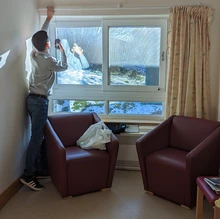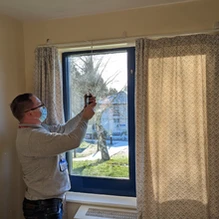How well do you know your Curtain Track Gliders?
- Greg Myatt
- Feb 15, 2023
- 3 min read
Updated: Feb 25
Further to a recent LinkedIn post regarding curtain track gliders, we thought it timely to explain some more on this.
Within the many buildings of healthcare providers in the UK, there are a number of different curtain tracks used for windows, shower, privacy and cubicle tracks. It is very important to ensure providers know and understand what systems they have installed so as they are aware of the different risks associated with each one especially within the mental health environments.
Fixed versus load release: some curtain tracks are designed to collapse when a load is applied of more than 40kg maximum, whereas other tracks are designed to be permanently fixed in place and instead release their gliders from the tracks. Both systems have a place and are suited to different requirements and no one product is ever suitable for all scenarios.
Where a curtain track physically collapses and is designed to fall away from its brackets, this can pose further risks such as accidental injury or weapon risk. However, where a track is permanently fixed in place and the gliders are designed to release, this can pose risks such as choke hazard of small parts, incorrect gliders being used or the glider configuration incorrect causing higher break away point.
Accidental Injury – where a product collapses by accident as opposed to be used for self-harm or ligature for example a person holding onto a curtain to steady themselves bringing the track and curtain down resulting in them falling and hurting themselves
Weapon Risk – where a product can be used as a weapon for self-harm or harm to others if taken down from its fixings
Choke Hazard – where items are swallowed deliberately to cause harm or injury
Incorrect Gliders – where gliders are used in a track that are not designed to release their load, resulting in very high loads (in excess of 40kg) being able to be supported from the curtain tracks
Different Glider Configuration – the mixing up or adding to of gliders to increase the breakaway load point
The curtain tracks we came across recently, relating to last week’s post, were where the track was permanently top fixed in place and designed to be used in conjunction with load release gliders. In this case there were standard gliders that were in place as well as load release type gliders which meant that loads of over 40kg were able to be achieved due to the fact that the standard gliders were not designed to release their load. Whilst the load release gliders released the curtains, the standard gliders continued to hold the curtain even after the load exceeded 40kg. In this scenario, the risk of ligature is inevitable.

To conclude, we strongly advise that all curtain tracks are regularly inspected to ensure that they are fit for purpose, safe and functioning as they should be. As well as this and in accordance to the HTM66, all curtain tracks should be annually inspected and load tested as a minimum however we always advise clients to ensure monthly checks are being carried out so as changes or abnormalities are picked up.
*Note that this post does not specifically mention any one manufacturer and instead focuses on the different types of functionality of curtain tracks. Whilst each manufacturer offers relevant subject matter and marketing material it is always important to understand your requirements first and then look at every option ensuring that the risk matrix is used to identify the best solution for your environments. At Protects Plus we are always happy to support clients that are working through this process to advise on what is the best solution for their needs.
For more information or if you have any other questions, please reach out as we would love to hear from you or why not book a Teams Meeting today
Email: enquiries@protects-plus.co.uk or Call: +44(0)345 646 0955
Visit: www.protects-plus.co.uk to find out more









Comments